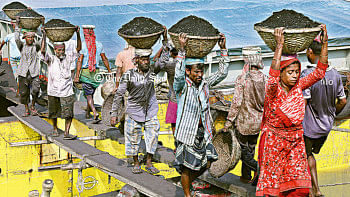Goat hides going for as little as Tk 10

Like the previous few years, the price of rawhide is low this year.
The demand from seasonal traders have been low but there were no reports of people throwing away the hides.
Some traders in Dhaka today said the traders were offering prices lower than that fixed by the government. Hides of large cows were going for Tk 900 to Tk 950, of medium-size cows Tk 600-750, and small cows Tk 500 or less.
Goat hides were being sold at Tk 30 to Tk 40 each. In two places in the capital, they were being sold for as little as Tk 10.
Aftab Khan, a trader in Posta, one of the leather hubs of the capital, said there's no demand of goat hides in the international market, leading to low prices locally.
Rezwan Rahman, a resident of Kalabagan area of the capital, said, "I sold the hide of a cow worth about Tk 1 lakh for Tk 950. But even 5-6 years ago, the price of the hide was Tk 1,400 to Tk 1,500."
"The demand is lower now than we saw before," he said.
The government this year hiked the prices of salt-applied hides by 6 percent to Tk 50-55 per square foot in Dhaka.
Outside the capital, the prices are between Tk 45 and Tk 48 per sqft.
The prices of goat hides have been fixed at Tk 12-20 per square foot nationwide.
In Bangladesh, Eid-ul-Azha accounts for half of the rawhides that tanners collect throughout the year.
Tipu Sultan, general secretary of the Bangladesh Hide and Skin Merchants' Association, said they have set a target of collecting one lakh pieces at Posta in Dhaka this Eid.
About 85,000 pieces have been collected so far. The rest is expected to be done by Saturday, he said.
Many traders in Posta have alleged that they are not getting their arrears from tanners.
A trader in Posta said from 2015 until now, nearly Tk 100 crore was pending.
Shaheen Ahamed, chairman of the Bangladesh Tanners Association, said they have set a target of collecting 85-90 lakh pieces of hides. So far, 5 to 6 percent of it reached the tannery estate.
Currently, the central effluent treatment plant at the Savar Tannery Industrial Estate has the capacity to treat 25,000 to 30,000 cubic metres of liquid waste. But during Eid-ul-Azha, waste generation climbs to 45,000 cubic metres.


 For all latest news, follow The Daily Star's Google News channel.
For all latest news, follow The Daily Star's Google News channel. 



Comments